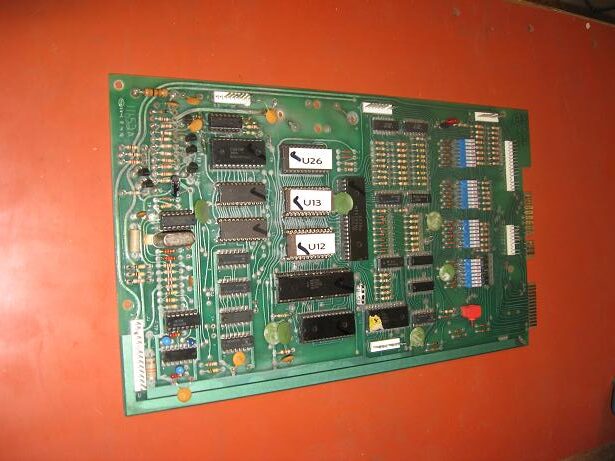Customer was having trouble getting their Sharpshooter 2 MPU to boot. It had the typical gameplan battery rot (actually it was very mild) and they had rebuilt the reset section, replaced the old PROMs with EPROMs and rejumpered, replaced 3 corroded sockets and still could not get the board to boot, so they called in Firebird Pinball to help.
Now initially the Gameplan MPU appears to be similar to the Bally MPU with the diagnostic flashes and the battery corrosion, but the diagnostics on the Gameplan board are a false promise.
The board is supposed to flash 6 times and each flash means a particular chip or section passed the test. So the idea is if you only get a couple of flashes the board can help you troubleshoot the issue. But in reality it doesn’t work this way. Most of the time if any of the 17 chips on the bottom 2/3’s of the board are bad you will get Zero flashes, none.
First thing to do it check out the prior work and everything looked OK. the reset and clock sections were working correctly. All socketed chips were pulled and tested in a known working Gameplan MPU and everything was good. So the next thing to do was to start tracing address and data lines to find a short or open trace. Always start with the EPROM sockets as these are the first ones to go on an MPU-2. And the best place to probe these are on the chip legs and not the sockets. A4 was missing at the EPROM at U12, The trace to the socket was good, but the socket itself was bad. Replaced all the eprom sockets and still not booting.
The 6651 RAM sockets were also near the corrosion zone and these 2 sockets looked worse than the EPROM sockets so we swapped these and now Presto, board boots, but we still have an issue. There is a long pause in between the 2nd and 3rd flash. So either a timing issue or a RAM issue and since we already socketed the RAM, we instead replaced the crusty looking Z80CTC timer and now we get all 6 flashes correctly timed. When the chips were tested in the other board they were only tested to the first flash and this is how this chip snuck past us.
Now we just have to pop it into a machine and check the I/O (displays, switches, lamps, solenoids) and we are through.
Also, there is a repro MPU-2 board available, so if the board is completely battery ravaged (requiring 7+ sockets swapped and many traces fixed) it is not worth the expense to send it out for repair, just purchase a new one.

